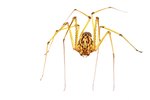
Black widows, especially the females, provide a warning to predators: the bright red hourglass set off the black abdomen background tells predators the spiders aren't tasty. However, a few creatures look at the hourglass as a sign of their next meal because the toxins inside the black widows don't upset their stomachs.
Insects
Not many insects prey on black widows, but a praying mantis considers several types of spiders, including black widows, a pleasant meal. A praying mantis usually goes after small insects, but he won't turn down an easy meal of black widow; the females stay relatively sedentary in their webs, although they might leave if threatened. Some wasps, especially the mud-dauber wasp, also don't shy away from black widows; they sting the spiders to paralyze them before devouring them.
Reptiles
Most reptiles avoid black widows because the arachnids' toxin can upset the reptiles' stomachs. Alligator lizards, however, have no problem eating black widows. They are well able to counteract toxins, and they eat other venomous insects including scorpions. These lizards eat just about anything they can find, including other lizards, mice and bird eggs as well as spiders.
Birds
Birds commonly eat spiders. They serve a vital ecosystem role of keeping spider populations at manageable levels in many areas. However, most won't eat a black widow more than once. No birds actively prey on black widow spiders. When a bird eats a black widow, he suffers stomach upset from the toxins found inside the spider. He's unlikely to die, but he won't make the mistake of ignoring the hourglass warning a second time.
Spiders
Most spiders avoid preying on black widows, except for other black widows. Their very name comes from the fact that the females sometimes eat the males after mating, although this isn't always the case. Young black widow spiderlings are notorious cannibals; eating their brothers and sisters is one reason fewer than 30 spiders out of 100 to 400 per egg sac typically survive past their first molting.
References
Photo Credits
-
Jupiterimages/Photos.com/Getty Images


